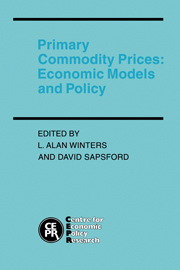Book contents
- Frontmatter
- Contents
- List of figures
- List of tables
- Preface
- List of conference participants
- 1 Primary commodity prices: an introduction to the major policy and modelling challenges
- I ECONOMETRIC ANALYSES
- II SECTORAL STUDIES: FOODS, MATERIALS AND ENERGY
- III STABILIZATION SCHEMES
- 8 The role of futures markets as stabilizers of commodity earnings
- 9 Primary commodity prices and exchange-rate volatility
- 10 Commodity policy: price stabilization versus financing
- Index
9 - Primary commodity prices and exchange-rate volatility
from III - STABILIZATION SCHEMES
Published online by Cambridge University Press: 05 March 2012
- Frontmatter
- Contents
- List of figures
- List of tables
- Preface
- List of conference participants
- 1 Primary commodity prices: an introduction to the major policy and modelling challenges
- I ECONOMETRIC ANALYSES
- II SECTORAL STUDIES: FOODS, MATERIALS AND ENERGY
- III STABILIZATION SCHEMES
- 8 The role of futures markets as stabilizers of commodity earnings
- 9 Primary commodity prices and exchange-rate volatility
- 10 Commodity policy: price stabilization versus financing
- Index
Summary
Introduction
It is well known that primary commodity prices show large fluctuations. Their causes and effects have been a matter of interest for a long time. Agricultural economists have focused upon firm-level aspects (like producer's income, planting decisions and the like) whereas development economists directed their attention towards macroeconomic aspects (e.g., welfare measures, changing terms of trade). Crucial in most studies is the question how to lessen the volatility of prices. Futures markets for commodities are usually found to be a stabilizing factor in these markets. Unfortunately, the investigation of interactions between markets (influencing primary commodities trading) has been neglected. A general equilibrium framework where futures prices themselves become endogenous is difficult to deal with. Most analysis in this direction, like Kawai (1983), is too general to provide insight into the specific effects of volatility on output and trade.
Several empirical studies like Chu and Morrison (1984), suggest a large number of economic indicators showing substantial correlation with commodity price volatility. How can one incorporate all uncertainties influencing the primary commodity market into one model? We chose to link the commodity market with the currency market, following Kawai and Zilcha (1986), as these seem to be the two variables of foremost interest. Since most primary commodities are traded internationally and are usually denominated in a few currencies, the exchange rate is believed to be one of the main factors of importance in production decisions.
- Type
- Chapter
- Information
- Primary Commodity PricesEconomic Models and Policy, pp. 213 - 239Publisher: Cambridge University PressPrint publication year: 1990
- 1
- Cited by



